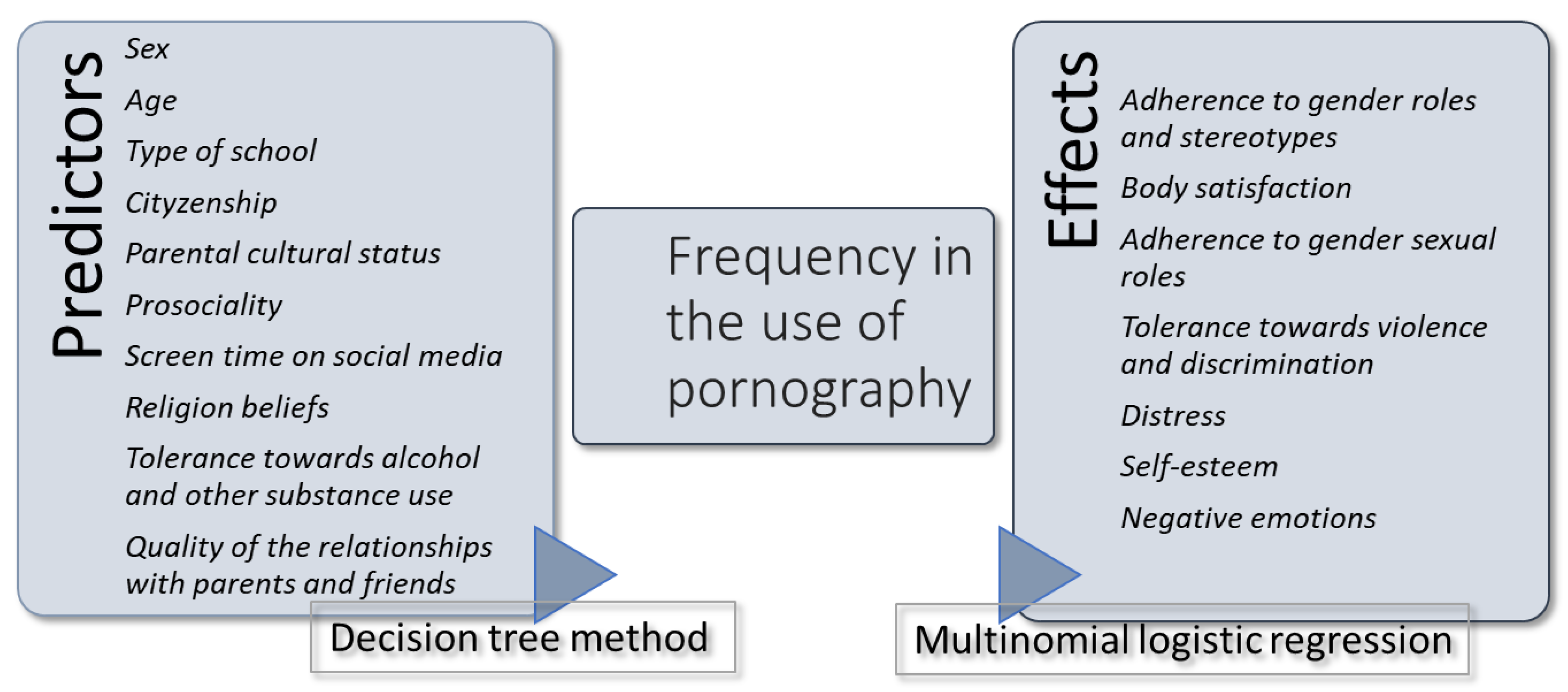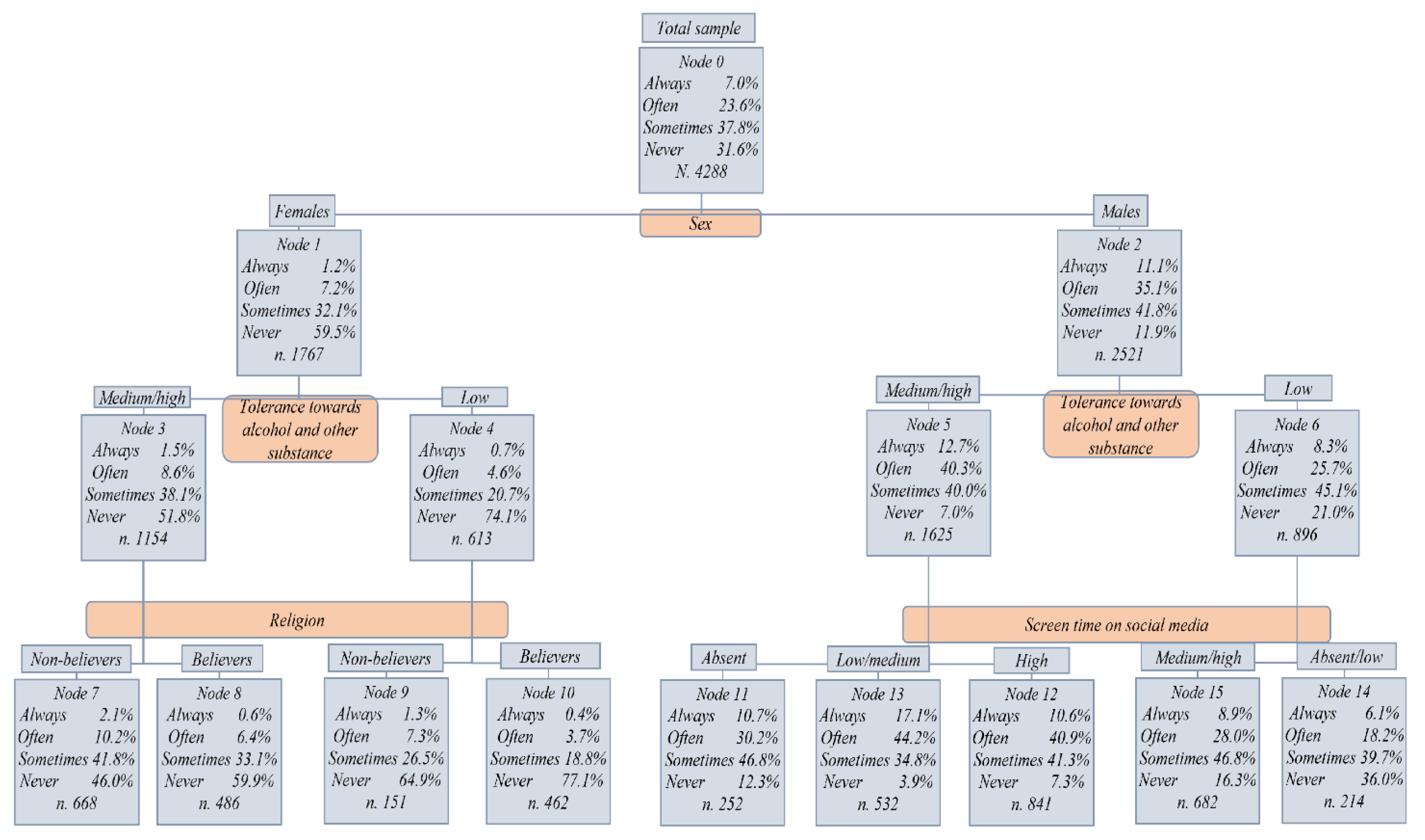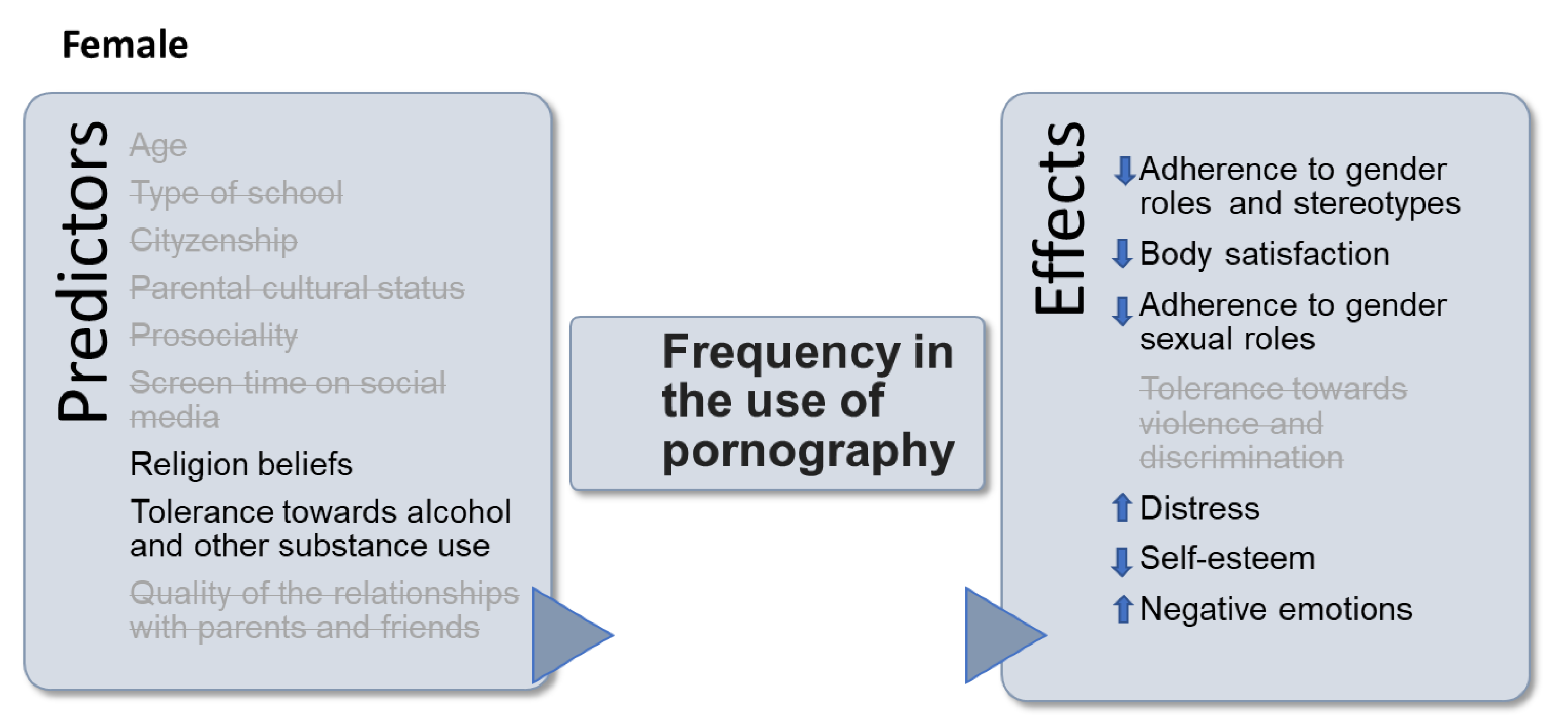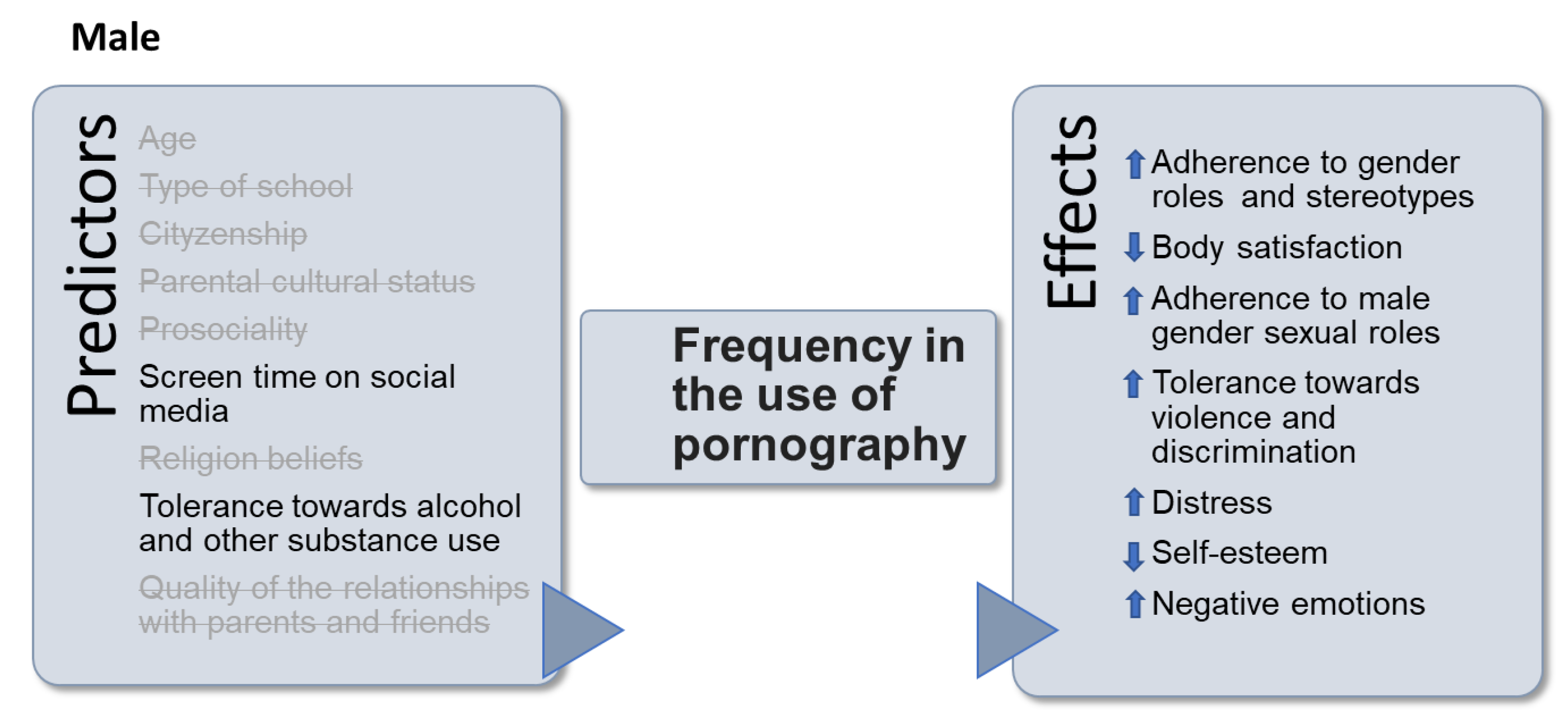The (Un)Equal Effect of Binary Socialisation on Adolescents’ Exposure to Pornography: Girls’ Empowerment and Boys’ Sexism from a New Representative National Survey
Abstract
1. Introduction
1.1. Pornography Consumption among Adolescents
1.2. The Main Correlates of Pornography Consumption
1.3. Pornography, Sexual Objectification of Women and Gender Norms
1.4. The Present Study
2. Materials and Methods
2.1. Sampling Method and Research Tool
2.2. Participants
2.3. Data Analysis
2.4. Measures
3. Results
3.1. Decision Tree Model
3.2. Multinomial Logistic Regression
4. Discussion
5. Conclusions
Author Contributions
Funding
Institutional Review Board Statement
Informed Consent Statement
Data Availability Statement
Conflicts of Interest
References
- Grubbs, J.B.; Perry, S.L.; Weinandy, J.T.G.; Kraus, S.W. Porndemic? A longitudinal study of pornography use before and during the COVID-19 pandemic in a nationally representative sample of Americans. Arch. Sex. Behav. 2022, 51, 123–137. [Google Scholar] [CrossRef] [PubMed]
- Luscombe, B. Porn and the threat to virility. The first generation of men who grew up with unlimited online porn sound the alarm. Time 2016, 187, 40–47. [Google Scholar] [PubMed]
- Peter, J.; Valkenburg, P.M. The use of sexually explicit Internet material and its antecedents: A longitudinal comparison of adolescents and adults. Arch. Sex. Behav. 2011, 40, 1015–1025. [Google Scholar] [CrossRef]
- Children’s Commissioner. Online pornography: Young People’s Experience of Seeing Online Porn and the Impact It Has on Them, UK Government. 2016. Available online: https://www.childrenscommissioner.gov.uk/about-us/the-childrens-commissioner-for-england/ (accessed on 12 April 2022).
- Kar, S.K.; Choudhury, A.; Singh, A.P. Understanding normal development of adolescent sexuality: A bumpy ride. J. Hum. Reprod. Sci. 2015, 8, 70–74. [Google Scholar] [CrossRef]
- Price, J.; Patterson, R.; Regnerus, M.; Walley, J. How much more XXX is generation X consuming? Evidence of changing attitudes and behaviors related to pornography since 1973. J. Sex Res. 2016, 53, 12–20. [Google Scholar] [CrossRef]
- Zattoni, F.; Gül, M.; Soligo, M.; Morlacco, A.; Motterle, G.; Collavino, J.; Barneschi, A.C.; Moschini, M.; Moro, F.D. The impact of COVID-19 pandemic on pornography habits: A global analysis of Google Trends. Int. J. Impot. Res. 2020, 33, 824–831. [Google Scholar] [CrossRef]
- Pornhub. The 2022 Year in Review. 2022. Available online: https://www.pornhub.com/insights/2022-year-in-review (accessed on 12 May 2023).
- Thurman, N.; Obster, F. The regulation of internet pornography: What a survey of under-18s tells us about the necessity for and potential efficacy of emerging legislative approaches. Policy Internet 2021, 13, 415–432. [Google Scholar] [CrossRef]
- Boniel-Nissim, M.; Efrati, Y.; Dolev-Cohen, M. Parental mediation regarding children’s pornography exposure: The role of parenting style, protection motivation and gender. J. Sex. Res. 2020, 57, 42–51. [Google Scholar] [CrossRef]
- Ballester-Arnal, R.; Castro-Calvo, J.; García-Barba, M.; Ruiz-Palomino, E.; Gil-Llario, M.D. Problematic and non-problematic engagement in online sexual activities across the lifespan. Comput. Human. Behav. 2021, 120, 106774. [Google Scholar] [CrossRef]
- Grubbs, J.B.; Exline, J.J.; Pargament, K.I.; Volk, F.; Lindberg, M.J. Internet pornography use, perceived addiction, and religious/spiritual struggles. Arch. Sex. Behav. 2017, 46, 1733–1745. [Google Scholar] [CrossRef] [PubMed]
- Solano, I.; Eaton, N.R.; O’Leary, K.D. Pornography consumption, modality, and function in a large internet sample. J. Sex. Res. 2020, 57, 92–103. [Google Scholar] [CrossRef] [PubMed]
- Peter, J.; Valkenburg, P.M. Adolescents and pornography: A review of 20 years of research. J. Sex Res. 2016, 53, 509–531. [Google Scholar] [CrossRef] [PubMed]
- Migheli, M.; Pronzato, C. Thinking as the others do: Persistence and conformity of sexual double standard among young Italians. Genus 2020, 76, 25. [Google Scholar] [CrossRef]
- Widman, L.; Evans, R.; Javidi, H.; Choukas-Bradley, S. Assessment of parent-based interventions for adolescent sexual health: Asystematic review and meta-analysis. JAMA Pediatr. 2019, 173, 866–877. [Google Scholar] [CrossRef]
- Farré, J.M.; Montejo, A.L.; Agulló, M.; Granero, R.; Chiclana Actis, C.; Villena, A.; Mestre-Bach, G. Pornography use in adolescents and its clinical implications. J. Clin. Med. 2020, 9, 3625. [Google Scholar] [CrossRef]
- Wright, P.J. Pornography consumption, cocaine use, and casual sex among U.S. adults. Psychol. Rep. 2012, 111, 305–310. [Google Scholar] [CrossRef] [PubMed]
- Morelli, M.; Bianchi, D.; Baiocco, R.; Pezzuti, L.; Chirumbolo, A. Sexting behaviors and cyber pornography addiction among adolescents: The moderating role of alcohol consumption. Sex. Res. Soc. Policy 2017, 14, 113–121. [Google Scholar] [CrossRef]
- George, M.; Maheshwari, S.; Chandran, S.; Rao, T.S.S. Psychosocial Aspects of Pornography. J. Psychosexual Health 2019, 1, 44–47. [Google Scholar] [CrossRef]
- Cardoso, J.; Ramos, C.; Brito, J.; Almeida, T.C. Predictors of pornography use: Difficulties in emotion regulation and loneliness. J. Sex. Med. 2022, 19, 620–628. [Google Scholar] [CrossRef]
- Perry, S.L. Pornography Use and Depressive Symptoms: Examining the Role of Moral Incongruence. Soc. Ment. Health 2018, 8, 195–213. [Google Scholar] [CrossRef]
- Hardy, S.A.; Steelman, M.A.; Coyne, S.M.; Ridge, R.D. Adolescent religiousness as a protective factor against pornography use. J. Appl. Dev. Psychol. 2013, 34, 131–139. [Google Scholar] [CrossRef]
- Rasmussen, K.; Bierman, A. How does religious attendance shape trajectories of pornography use across adolescence? J. Adolesc. 2016, 49, 191–203. [Google Scholar] [CrossRef] [PubMed]
- Vandenbosch, L.; van Oosten, J.M.; Peter, J. Sexually explicit internet material and adolescents’ sexual performance orientation: The mediating roles of enjoyment and perceived utility. Media Psychol. 2018, 21, 50–74. [Google Scholar] [CrossRef]
- Camoletto, R.F. From Sexual Objectification to Sexual Subjectification? Pornography Consumption and Italian Women’s Sexual Empowerment. AG About Gend. 2019, 8, 129–157. [Google Scholar] [CrossRef]
- Daskalopoulou, A.; Zanette, M.C. Women’s consumption of pornography: Pleasure, contestation, and empowerment. Sociology 2020, 54, 969–986. [Google Scholar] [CrossRef]
- Guggisberg, M.; Holt, A. Attitudes and Sexual Behaviours Associated with Adolescent Online Pornography Consumption: A Critical Commentary During COVID-19. J. Soc. Psychol. Res. 2022, 1, 164–175. [Google Scholar] [CrossRef]
- Massey, K.; Burns, J.; Franz, A. Young people, sexuality and the age of pornography. Sex. Cult. 2021, 25, 318–336. [Google Scholar] [CrossRef]
- Wright, P.J.; Sun, C.; Steffen, N.J.; Tokunaga, R.S. Pornography, alcohol, and male sexual dominance. Commun. Monogr. 2014, 4, 252–270. [Google Scholar] [CrossRef]
- Wright, P.J.; Tokunaga, R.S.; Kraus, A. A meta-analysis of pornography consumption and actual acts of sexual aggression in general population studies. J. Commun. 2016, 66, 183–205. [Google Scholar] [CrossRef]
- Kohut, T.; Landripet, I.; Štulhofer, A. Testing the confluence model of the association between pornography use and male sexual aggression: A longitudinal assessment in two independent adolescent samples from Croatia. Arch. Sex. Behav. 2021, 50, 647–665. [Google Scholar] [CrossRef]
- Peter, J.; Valkenburg, P.M. Adolescents’ exposure to a sexualized media environment and their notions of women as sex objects. Sex. Roles 2007, 56, 381–395. [Google Scholar] [CrossRef]
- Paslakis, G.; Chiclana Actis, C.; Mestre-Bach, G. Associations between pornography exposure, body image and sexual body image: A systematic review. J. Health Psychol. 2022, 27, 743–760. [Google Scholar] [CrossRef]
- Mattebo, M.; Larsson, M.; Tydén, T.; Olsson, T.; Häggström-Nordin, E. Hercules and Barbie? Reflections on the influence of pornography and its spread in the media and society in groups of adolescents in Sweden. Eur. J. Contracept. Reprod. Health Care 2012, 17, 40–49. [Google Scholar] [CrossRef]
- Kim, Y.H. Adolescents’ health behaviours and its associations with psychological variables. Cent. Eur. J. Public Health 2011, 19, 205–209. [Google Scholar] [CrossRef]
- Morrison, T.G.; Harriman, R.; Morrison, M.A.; Bearden, A.; Ellis, S.R. Correlates of exposure to sexually explicit material among Canadian post-secondary students. Can. J. Human Sex. 2004, 13, 143–156. [Google Scholar]
- Stanley, N.; Barter, C.; Wood, M.; Aghtaie, N.; Larkins, C.; Lanau, A.; Överlien, C. Pornography, Sexual Coercion and Abuse and Sexting in Young People’s Intimate Relationships: A European Study. J. Interpers. Violence 2018, 33, 2919–2944. [Google Scholar] [CrossRef]
- Wood, M.; Barter, C.; Stanley, N.; Aghtaie, N.; Larkins, C. Images across Europe: The sending and receiving of sexual images and associations with interpersonal violence in young people’s relationships. Child. Youth Serv. Rev. 2015, 59, 149–160. [Google Scholar] [CrossRef]
- Marcano Belisario, J.S.; Jamsek, J.; Huckvale, K.; O’Donoghue, J.; Morrison, C.P.; Car, J. Comparison of self-administered survey questionnaire responses collected using mobile apps versus other methods. Cochrane Database Syst. Rev. 2015. [Google Scholar] [CrossRef]
- Kotu, V.; Deshpande, B. Data Science: Concepts and Practice; Morgan Kaufmann: Burlington, MA, USA, 2018. [Google Scholar]
- Caprara, G.V.; Steca, P.; Zelli, A.; Capanna, C. A new scale for measuring adults’ prosocialness. Eur. J. Psychol. Assess. 2005, 2, 77–89. [Google Scholar] [CrossRef]
- Rosenberg, M. Rosenberg self-esteem scale. J. Relig. Health 1965, 61, 18. [Google Scholar]
- Kessler, R.C.; Andrews, G.; Colpe, L.J.; Hiripi, E.; Mroczek, D.K.; Normand, S.-L.T.; Walters, E.E.; Zaslavsky, A.M. Short screening scales to monitor population prevalences and trends in non-specific psychological distress. Psychol. Med. 2002, 32, 959–976. [Google Scholar] [CrossRef] [PubMed]
- Osgood, C.E. Semantic differential technique in the comparative study of cultures. Am. Anthropol. 1964, 66, 171–200. [Google Scholar] [CrossRef]
- Mead, D.; Sharpe, M. Aligning the “Manifesto for a European research network into problematic usage of the Internet” with the diverse needs of the professional and consumer communities affected by problematic usage of pornography. Int. J. Environ. Res. Public Health 2020, 17, 3462. [Google Scholar] [CrossRef] [PubMed]
- Menicocci, M. Pornografia di Massa: Dalla Rivoluzione Sessuale alla Porn Culture; Edizioni Altravista: Pavia, Italy, 2014. [Google Scholar]
- Cerbara, L.; Ciancimino, G.; Tintori, A. Are we still a sexist society? Primary socialisation and adherence to gender roles in childhood. Int. J. Environ. Res. Public Health 2022, 19, 3408. [Google Scholar] [CrossRef]
- Bem, S.L. The Lenses of Gender: Transforming the Debate on Sexual Inequality; Yale University Press: London, UK, 1993. [Google Scholar]
- Capurso, M.; D’Urzo, E.; Palomba, R.; Federici, S. Pornography use, sexual behaviours, and emotional intelligence in italian adolescents. Pornography use, sexual behaviours, and emotional intelligence in italian adolescents. Psicol. Della Salut. 2020, 71–96. [Google Scholar] [CrossRef]
- Fernandes, B.; Biswas, U.N.; Mansukhani, R.T.; Casarín, A.V.; Essau, C.A. The impact of COVID-19 lockdown on internet use and escapism in adolescents. Rev. De Psicol. Clínica Con Niños Y Adolesc. 2020, 7, 59–65. [Google Scholar] [CrossRef]
- McCormack, M.; Wignall, L. Enjoyment, exploration and education: Understanding the consumption of pornography among young men with non-exclusive sexual orientations. Sociology 2017, 51, 975–991. [Google Scholar] [CrossRef]
- Attwood, F.; Smith, C.; Barker, M. ‘I’m just curious and still exploring myself’: Young people and pornography. New Media Soc. 2018, 20, 3738–3759. [Google Scholar] [CrossRef]




| Always | Often | Occasionally | Never | ||
|---|---|---|---|---|---|
| Sex | Male | 11.1% | 35.1% | 41.8% | 11.9% |
| Female | 1.2% | 7.2% | 32.1% | 59.5% | |
| Total | 7.0% | 23.6% | 37.8% | 31.6% | |
| Class | I | 8.4% | 18.3% | 35.4% | 37.9% |
| II | 7.4% | 22.1% | 36.0% | 34.6% | |
| III | 7.2% | 25.4% | 38.6% | 28.8% | |
| IV | 5.5% | 28.9% | 38.9% | 26.8% | |
| V | 6.6% | 24.1% | 40.7% | 28.6% | |
| Citizenship | Italian | 7.0% | 24.1% | 37.9% | 31.0% |
| Foreign | 8.0% | 16.9% | 36.4% | 38.7% | |
| Type of school | High school | 5.8% | 23.9% | 37.6% | 32.7% |
| Technical institute | 8.9% | 28.4% | 40.4% | 22.3% | |
| Vocational school | 6.6% | 17.9% | 35.3% | 40.2% | |
| Religion beliefs | Believer | 5.1% | 18.8% | 35.9% | 40.2% |
| Non-believer | 8.5% | 28.1% | 41.0% | 22.4% | |
| Parental cultural status | Low | 6.3% | 21.7% | 33.0% | 39.0% |
| Medium | 7.4% | 24.7% | 39.0% | 28.9% | |
| High | 5.9% | 21.5% | 36.1% | 36.5% |
| Sex | Independent Variable * | Dependent Variable ** | OR | Confidence Interval |
|---|---|---|---|---|
| Female | ||||
| FreqPFY | Female gender roles (high) | 0.403 | 0.202–0.807 | |
| FreqPFY | Female gender roles (low) | 0.622 | 0.503–0.770 | |
| FreqPFY | Male gender roles (high) | 0.326 | 0.182–0.584 | |
| FreqPFY | Male gender roles (medium) | 0.545 | 0.405–0.733 | |
| FreqPFY | Self-esteem (high) | 0.444 | 0.313–0.632 | |
| FreqPFY | Self-esteem (good) | 0.603 | 0.493–0.738 | |
| FreqPFY | Distress (high) | 3.717 | 2.717–5.085 | |
| FreqPFY | Distress (medium) | 2.075 | 1.462–2.944 | |
| FreqPFY | Gender stereotypes (high) | 0.215 | 0.103–0.449 | |
| FreqPFY | Gender stereotypes (medium) | 0.307 | 0.214–0.442 | |
| FreqPFY | Gender stereotypes (low) | 0.679 | 0.552–0.836 | |
| FreqPFY | Body satisfaction (not) | 1.390 | 1.144–1.688 | |
| FreqPFY | Perception of negative emotions (high) | 1.905 | 1.412–2.572 | |
| FreqPFY | Perception of negative emotions (medium) | 1.522 | 1.119–2.070 | |
| Male | ||||
| FreqPMY | Female gender roles (high) | 1.681 | 1.256–2.248 | |
| FreqPMY | Female gender roles (medium) | 1.557 | 1.229–1.972 | |
| FreqPMY | Male gender roles (high) | 2.067 | 1.644–2.599 | |
| FreqPMY | Male gender roles (medium) | 1.407 | 1.127–1.757 | |
| FreqPMY | Sexual gender roles (male dominance) | 1.927 | 1.599–2.322 | |
| FreqPMY | Self-esteem (high) | 0.535 | 0.422–0.677 | |
| FreqPMY | Self-esteem (good) | 0.759 | 0.627–0.919 | |
| FreqPMY | Distress (high) | 1.741 | 1.400–2.164 | |
| FreqPMY | Distress (medium) | 1.665 | 1.311–2.116 | |
| FreqPMY | Distress (low) | 1.507 | 1.233–1.843 | |
| FreqPMY | Tolerance towards violence and discrimination (low) | 0.585 | 0.474–0.723 | |
| FreqPMY | Body satisfaction (not) | 1.612 | 1.366–1.902 | |
| FreqPMY | Perception of negative emotions (high) | 1.695 | 1.358–2.117 | |
| FreqPMY | Perception of negative emotions (medium) | 1.414 | 1.187–1.684 |
Disclaimer/Publisher’s Note: The statements, opinions and data contained in all publications are solely those of the individual author(s) and contributor(s) and not of MDPI and/or the editor(s). MDPI and/or the editor(s) disclaim responsibility for any injury to people or property resulting from any ideas, methods, instructions or products referred to in the content. |
© 2023 by the authors. Licensee MDPI, Basel, Switzerland. This article is an open access article distributed under the terms and conditions of the Creative Commons Attribution (CC BY) license (https://creativecommons.org/licenses/by/4.0/).
Share and Cite
Cerbara, L.; Ciancimino, G.; Corsetti, G.; Tintori, A. The (Un)Equal Effect of Binary Socialisation on Adolescents’ Exposure to Pornography: Girls’ Empowerment and Boys’ Sexism from a New Representative National Survey. Societies 2023, 13, 146. https://doi.org/10.3390/soc13060146
Cerbara L, Ciancimino G, Corsetti G, Tintori A. The (Un)Equal Effect of Binary Socialisation on Adolescents’ Exposure to Pornography: Girls’ Empowerment and Boys’ Sexism from a New Representative National Survey. Societies. 2023; 13(6):146. https://doi.org/10.3390/soc13060146
Chicago/Turabian StyleCerbara, Loredana, Giulia Ciancimino, Gianni Corsetti, and Antonio Tintori. 2023. "The (Un)Equal Effect of Binary Socialisation on Adolescents’ Exposure to Pornography: Girls’ Empowerment and Boys’ Sexism from a New Representative National Survey" Societies 13, no. 6: 146. https://doi.org/10.3390/soc13060146
APA StyleCerbara, L., Ciancimino, G., Corsetti, G., & Tintori, A. (2023). The (Un)Equal Effect of Binary Socialisation on Adolescents’ Exposure to Pornography: Girls’ Empowerment and Boys’ Sexism from a New Representative National Survey. Societies, 13(6), 146. https://doi.org/10.3390/soc13060146







